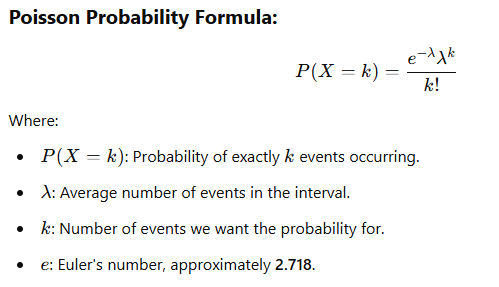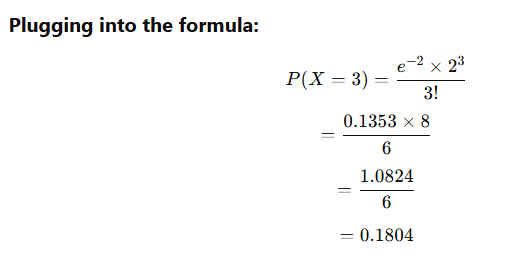Let’s break down the various queueing systems that involve Poisson-exponential (i.e., Poisson arrival process with exponentially distributed service times) and deterministic systems, explaining each in detail:
This problem in queueuing system generally involves the Poisson distribution, which is used to model the probability of a given number of events occurring in a fixed interval of time or space.

Example:
If on average 2 customers arrived at shopping mall per minute. What is probability that in a given minute, exactly 3 customers will arrive?
e^-2 = .1353
Given:
-
λ (Average number of customers per minute)
-
k = 3 (Number of customers we want to find the probability for)
-
e^−2 = 0.1353

Basic Assumptions of Poisson-Exponential Queueing Model
- Queue Discipline: First In First Out (FIFO)
- No balking: Customers do not leave the system just because the queue is long or they perceive a delay.
- No reneging: Customers do not leave the queue once they have entered it, even if the waiting time becomes long.
- Arrivals:
- Poisson Distributed
- Independent arrivals, constant rate over time
- Customers come from a very large population
- Service Times:
- Negative Exponential probability distribution
- Average known
- Average Service rate > Average Arrival rate.
1. Poisson-Exponential Single Server (M/M/1 Queue)
- M/M/1 stands for :
- M (Markovian/Memoryless) arrival process (Poisson process, meaning customers arrive randomly at a constant average rate, λ).
- M (Markovian/Memoryless) service process (exponentially distributed service times with rate μ).
- 1 indicates a single server.
In the M/M/1 queue, there is a single server serving customers who arrive according to a Poisson process with an arrival rate λ, and each customer is served in exponentially distributed time with a service rate .
- Key characteristics:
- Arrival rate (): The average number of customers arriving per unit of time.
- Service rate (): The average number of customers the server can serve per unit of time.
- Utilization (ρ): The fraction of time the server is busy, .
- If λ>, the system is unstable, leading to growing queue lengths.
2. Poisson-Exponential Dual Server (M/M/2 Queue)
- M/M/2 stands for:
- M arrival process (Poisson process).
- M service process (exponentially distributed service times).
- 2 indicates two servers.
The M/M/2 queue is a special case of the M/M/c queue where there are exactly two servers. Customers arrive following a Poisson process with arrival rate , and each server has an exponential service time with service rate .
-
Key characteristics:
- Arrival rate (): The average number of customers arriving per unit of time.
- Service rate (): The average rate at which each server can serve customers.

-
- Two servers: With two servers, customers are either served immediately by one of the available servers or must wait in the queue if both servers are busy.
-
Performance Metrics (for M/M/2 queue):
- The average waiting time and average number of customers in the system will generally be lower than an M/M/1 system because there are more servers available.
- The system’s performance is typically better than a single-server queue, especially when λ is high but not high enough to overwhelm the system.
3. Poisson-Exponential Multiple Server (M/M/c Queue)
- M/M/c stands for:
- M arrival process (Poisson process).
- M service process (exponentially distributed service times).
- c indicates the number of servers.
In the M/M/c queue, there are c servers serving customers. Each customer arrives following a Poisson process with an average arrival rate λ, and each server can serve customers with an exponentially distributed service time at rate μ.
-
-
Key characteristics:
- Arrival rate (λ): The average number of customers arriving per unit of time.
- Service rate (μ): The average number of customers served by each server per unit of time.
- Number of servers (c): There are cc parallel servers that can serve customers simultaneously.
- Utilization: The average utilization of each server is ρ=λ/cμ.
-
Performance Metrics:
- The system becomes more efficient as you increase the number of servers. However, if there are too many customers arriving (i.e., ), a queue will form and the system will become congested.
-
4. Deterministic Queue (D/D/1 or D/D/c Queue)
- D/D/1 or D/D/c stands for:
- D (Deterministic) arrival process (arrivals occur at a fixed, predictable rate).
- D (Deterministic) service process (service times are fixed and known).
- 1 or c indicates the number of servers.
In a deterministic queue, both arrival times and service times are constant and deterministic (i.e., they occur at fixed intervals). For instance:
-
In a D/D/1 queue, customers arrive at fixed intervals (e.g., one customer arrives every 5 minutes), and each customer is served in a deterministic (constant) amount of time (e.g., 5 minutes).
-
Key characteristics:
- The arrival rate is constant and deterministic.
- The service rate is also constant and deterministic.
- No randomness in inter-arrival times or service times.
- This is a highly predictable system, unlike Poisson-exponential models, which involve randomness in arrival and service times.
-
Performance:
- Since both the arrival and service times are deterministic, the system’s performance is predictable. If the system is balanced (arrival rate equals service rate), the queue will always have exactly one customer being served, and no waiting will occur.
- However, if the service time is shorter than the inter-arrival time, customers may not even need to queue. Conversely, if the service time is longer than the inter-arrival time, customers will have to wait in line.